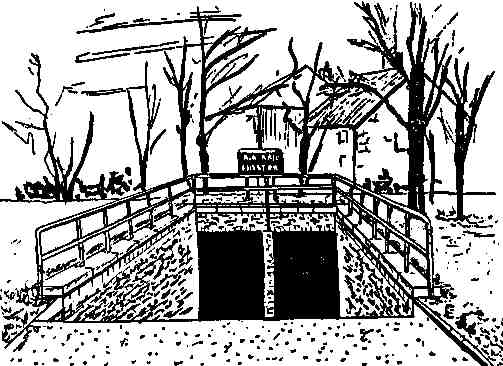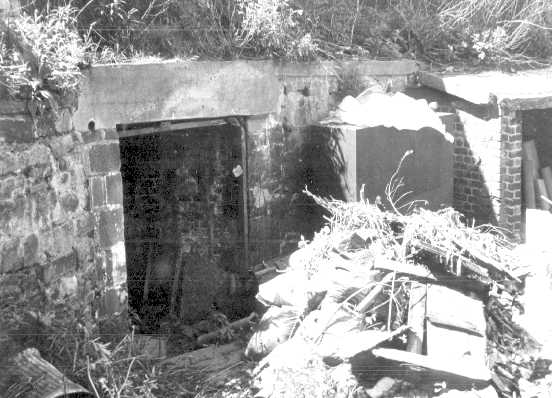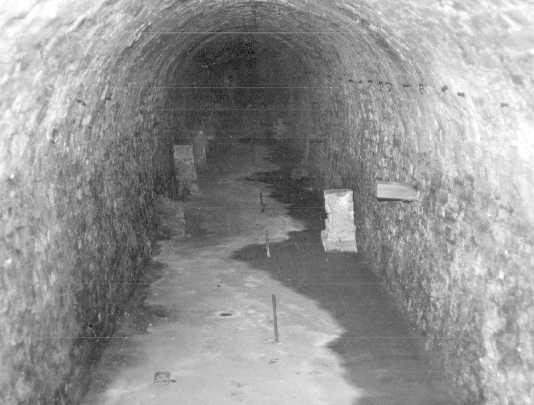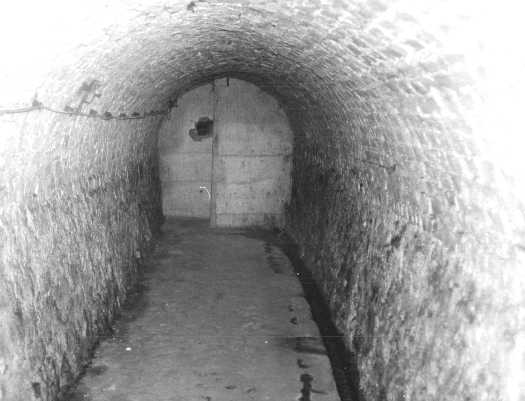
|
North-East Diary
|
| Previous Page | Front Page | Index |
|
Background
|
The Victoria Tunnel was completed on the 8th January 1842 and was officially opened on the 7th April 1842 by the Mayor. It is almost two miles in length from Spital Tongues Colliery to staithes on the Tyne near Glasshouse Bridge at foot of Tyne Street. It was closed Jan 1860.
In 1939 it was converted to an air-raid shelter at a cost of £37,000 - the seating capacity was 9,000. The walls were whitewashed and a Tarmac floor laid, electric lighting, bunks, seating and chemical toilets were installed. Overlapping pairs of thick concrete walls spaced about a yard apart were built to give protection against blast in case a bomb should pentrate into the tunnel or an entrance. These were located near the entrances and at intervals along the tunnel.
There were entrances at :-
The entrance on Ouse Street was at ground level in side of a slight hill. Others were formed by driving shafts, their lengths varying from 40 to 110yds and all except Ouse Street had one or more angled bends.
At end of war most of the fittings were removed and the entrances bricked up, except that at Ouse Street, this is the one remaining WW2 entrance, but it is located on private property. In 1976, an 800 metre section of tunnel in the vicinity of the Civic Centre was converted to a sewer but large sections at the east and west ends of the tunnel remain in their wartime condition. The Ouse Street entrance gives access to the eastern end of the tunnel and there is a manhole at the southern end of Claremont Road which gives access to western end of the tunnel. Plans to turn the tunnel into a tourist attraction were abandoned because of health and safety concerns, but occasional conducted tours have been permitted.

| Drawing by Ron Henderson, from a photograph deposited at Newcastle Central Library. The church itself is just off the picture to the right. |

| Note the toilet block to the right - the toilets associated with other entrances were underground. |

| Note the supports for the bunks and seats. |

| Note the lighting cable and fittings and the blast walls across the tunnel - these allowed easy passage for people, but prevented blast from bombs (and sound) from reaching other tunnel sections. |
Originally a branch of the ATS, the WAAF was made a separate force on 1st July 1939. Dame J. Trefusis Forbes DBE was made Director (at the Air Ministry) with the rank of Air Chief Commandant.
By the end of the war, of the 171,200 WAAFs, 187 were killed, 420 were wounded and 4 were listed as missing.
The Womens Land Army was originally formed during the War of 1914 - 1918. It was reconstituted in January 1939. During training they were paid 10s (50p) per week, plus board and lodging. The work included milking, dairy work, general farm duties, fruit and vegetable cultivation, the care of livestock, tractor driving and the hewing and measuring of timber. Their work was not as glamorous as the recruiting posters would have us believe, it was often dirty and back-breaking, it lasted from dawn till dusk and on average, earned the women a paltry £1/8/- per week, added to that they were often poorly clothed for the conditions in which they had to work, often poorly housed and fed too, in some cases by the very people they were sent to help. For some however the experience was very satisfying and some of the friendships made, endured. Almost 90,000 females between the ages of 18 and 40 served in the WLA during the war years. The uniform included khaki corduroy breeches, a shirt, a green pullover, a khaki felt pork-pie hat, a greatcoat and brown shoes. They were also issued with a pair of dungarees, a pair of boots and a pair of wellingtons. Even when they were 'demobbed' the Land Army personnel were not treated too well, they were only allowed to keep the greatcoat, the shirt and the pair of shoes, an issue of 20 clothing coupons was supposed to cover the rest.
Originally formed in 1917 the WRNS was revived on 14th April 1939, under the Directorship of Mrs Laughton Matthews, holding the rank equivalent to that of Rear-Admiral.
By the end of the war, of the 74,000 WRNS, 102 were killed and 22 were wounded.
The WVS performed sterling service during the war, their many talents were of great value, particularly after an air raid when they ran clothing distribution and rest centres for those people 'bombed out'. They kept Mobile Canteens open 24 hours a day, every day of the year, throughout the war. The Chairwoman was The Dowager Marchioness of Reading GBE.
The injured on Royal Navy or Merchant Navy ships had a very grim time. There was usually no one fully qualified to treat their injuries, they were invariably left to fend for themselves until the ship was made seaworthy, or otherwise the prospect of a dip in a rough and freezing sea would become reality, and with possibly having a broken limb, a gaping flesh wound or, a common injury among the boiler-room staff, a deep seated scald, the reality becomes even more grim.
Injured aircrew too, had a very grim and apprehensive wait for treatment, as with the navies, there was usually no one on board, qualified to treat the injured. The injuries were usually bullet or shrapnel punctures, burns from broken and burning fuel lines or flares, fractures caused by being tossed about in the aircraft during evasive action or a combination of any or all, compounded by the fact that under certain circumstances bleeding could be a lot faster than normal in a rarefied atmosphere. Then came the landing, if it was an untroubled affair, hopefully it wouldn't be bumpy, but if it was a crash-landing be it on land or water, then the agony suffered by the injured must have been beyond description.
| Previous Page | Front Page | Index |
![]() © Copyright
Brian Pears
1994-2011
© Copyright
Brian Pears
1994-2011